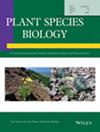伊朗戈勒斯坦国家公园三种植被的种子休眠状况及与世界数据库的比较
IF 1.3
4区 生物学
Q4 ECOLOGY
引用次数: 0
摘要
确定植物群落的种子休眠状况(SDP)可以帮助人们深入了解物种适应机制、群落结构和动态。伊朗戈勒斯坦国家公园(GNP)由不同类型的植被组成,即落叶温带森林、荒漠和大草原,这些植被相距很近,但环境因素各不相同。对这三种植被类型的植物种类、生命形式和种子休眠类型进行了测定,并生成了类型的 SDP,并与世界数据库中的相应类型进行了比较。在所有 GNP 植被类型中,分别有 80%-82% 和 2%-3% 的物种具有休眠(D)和非休眠(ND)种子,但有 17% 的物种休眠类型不明。生理休眠(PD)最多,其次是物理休眠(PY)。在 GNP 中,具有 ND 种子的物种比例明显比世界数据库中的低两三倍。马托拉尔的 PD 百分比明显高于世界数据库。与世界数据库相比,森林中的PY比例较高,但马托拉和草原中的PY比例较低。与全球数据库相比,森林中的形态生理学休眠百分比(MPD)明显较低,而马托拉草原和干草原中的形态生理学休眠百分比则较高。种子休眠状况不受全球植被数据库中植被类型远近的影响,但每种植被类型的休眠状况都与全球数据库中的休眠状况不同。过去的气候波动与现在该地区的季节性相关联,可能是导致大北方地区具有 D 种子的物种比例增加的选择性压力。本文章由计算机程序翻译,如有差异,请以英文原文为准。
The seed dormancy profile of three types of vegetation in Golestan National Park in Iran and a comparison with the world database
Defining the seed dormancy profile (SDP) of plant communities may provide insight into species adaptive mechanisms, community structure, and dynamics. Golestan National Park (GNP) in Iran consists of different types of vegetation, namely deciduous temperate forest, matorral, and steppe in close proximity but with variability of environmental factors. Plant species, life forms, and kinds of seed dormancy were determined in the three vegetation types, and a SDP of types was generated and compared with corresponding ones in the world database. In all GNP vegetation types, 80%–82% and 2%–3% of the species had dormant (D), and nondormant (ND) seeds, respectively, but in 17% the class of dormancy was unknown. Physiological dormancy (PD) was the most abundant followed by physical dormancy (PY). The species percentage with ND seeds in GNP was significantly two or three times lower than that in the world database. The PD percentage in the matorral was significantly higher than that in the world database. The PY percentage was higher in the forests but lower in the matorral and steppe compared with the world database. The morphophysiological (MPD) dormancy percentage was significantly lower in the forests but higher in the matorral and steppe than in the global database. Seed dormancy profiles were not affected by the proximity of vegetation types in the GNP, but they differed from those of the world database for each vegetation type. The past climatic fluctuations associated with the present‐day seasonality of the region might be the selective pressure for the increased percentage of species with D seeds in the GNP.
求助全文
通过发布文献求助,成功后即可免费获取论文全文。
去求助
来源期刊

Plant Species Biology
生物-生态学
CiteScore
2.70
自引率
14.30%
发文量
36
审稿时长
>12 weeks
期刊介绍:
Plant Species Biology is published four times a year by The Society for the Study of Species Biology. Plant Species Biology publishes research manuscripts in the fields of population biology, pollination biology, evolutionary ecology, biosystematics, co-evolution, and any other related fields in biology. In addition to full length papers, the journal also includes short research papers as notes and comments. Invited articles may be accepted or occasion at the request of the Editorial Board. Manuscripts should contain new results of empirical and/or theoretical investigations concerning facts, processes, mechanisms or concepts of evolutionary as well as biological phenomena. Papers that are purely descriptive are not suitable for this journal. Notes & comments of the following contents will not be accepted for publication: Development of DNA markers. The journal is introducing ''Life history monographs of Japanese plant species''. The journal is dedicated to minimizing the time between submission, review and publication and to providing a high quality forum for original research in Plant Species Biology.
 求助内容:
求助内容: 应助结果提醒方式:
应助结果提醒方式:


